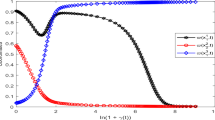Abstract
This paper presents an algorithm for computing approximations to a certain subset of Pareto optimal allocations in a public goods economy. Consumers are partitioned into a number of exogenous governmental jurisdictions, which provide public goods locally and raise revenue to cover their costs by means of a proportional wealth tax. The Pareto optimal allocations studied are consistent with profit maximization on the part of producers, and utility maximization over private goods bundles subject to after-tax budget constraints by consumers. The computational routine is based on the Scarf algorithm for computing fixed points.
Similar content being viewed by others
References
G. Debreu,The theory of value (Wiley, New York, 1959).
B. Ellickson, “A generalization of the pure theory of public goods”,American Economic Review 63 (1973) 417–432.
D. Foley, “Resource allocation and the public sector”,Yale Economic Essays 7 (1967) 43–98.
O.H. Merrill, “Applications and extensions of an algorithm that computes fixed points of certain non-empty convex upper semicontinuous point to set mappings”, Tech. Rept. No. 71-7, Department of Industrial Engineering, University of Michigan, Ann Arbor (1971).
J. Milleron, “Theory of value with public goods: a survey article”,Journal of Economic Theory 5 (1972) 419–477.
D. Richter, “Existence of a general equilibrium in multiregional economies with public goods”,International Economic Review 16 (1975) 201–221.
D. Richter, “The approximation of a public competitive equilibrium”, in: J. Los and M.W. Los, eds.,Computing equilibria: how and why? (North-Holland, Amsterdam, 1975).
D.J. Roberts, “Existence of Lindahl equilibrium with a measure space of consumers”,Journal of Economic Theory 6 (1973) 355–381.
J. Rothenberg, “Fiscal disparities in a metropolitan area: the public policy perspective”, Working Paper No. 60, Department of Economics, Massachusetts Institute of Technology, Cambridge (1970).
J. Rothenberg, “Local decentralization and the theory of optimal government”, in: J. Margolis, ed.,The analysis of public output (National Bureau of Economic Research, New York, 1970).
J. Rothenberg, “The impact of local government on intrametropolitan location”, Working Paper No. 45, Department of Economics, Massachusetts Institute of Technology, Cambridge (1971).
P. Samuelson, “Pure theory of public expenditure and taxation”, in: J. Margolis and H. Guitton, eds.,Public economics (MacMillan, New York, 1969).
H. Scarf, “On the computation of equilibrium prices”, in: W. Fellner et al., eds.,Ten essays in honor of Irving Fisher (Wiley, New York, 1967).
H. Scarf, with the collaboration of T. Hansen,The computation of economic equilibria (Yale University Press, New Haven, 1973).
J. Shoven and J. Whalley, “A general equilibrium calculation of the effects of differential taxation of income from capital in the U.S.”,Journal of Public Economics 3 (1972) 281–321.
J. Shoven and J. Whalley, “General equilibrium with taxes: a computational procedure and an existence proof”,Review of Economic Studies 40 (1973) 475–490.
Author information
Authors and Affiliations
Additional information
The origins of this research date back to the Dartmouth Workshop on “Applications to economics of new methods of computing fixed points”, held during the summer of 1972 under the direction of H. Scarf. The author wishes to thank the participants in this workshop for many stimulating discussions. Also the provision of computer time by the Computer Research Center of the National Bureau of Economic Research is gratefully acknowledged. FIXPOINT, an interactive computer system developed at the Computer Research Center, was used in performing the numerical computations presented in the paper.
Rights and permissions
About this article
Cite this article
Richter, D.K. The computation of a general equilibrium in a public goods economy. Mathematical Programming 14, 186–207 (1978). https://doi.org/10.1007/BF01588965
Received:
Revised:
Issue Date:
DOI: https://doi.org/10.1007/BF01588965




